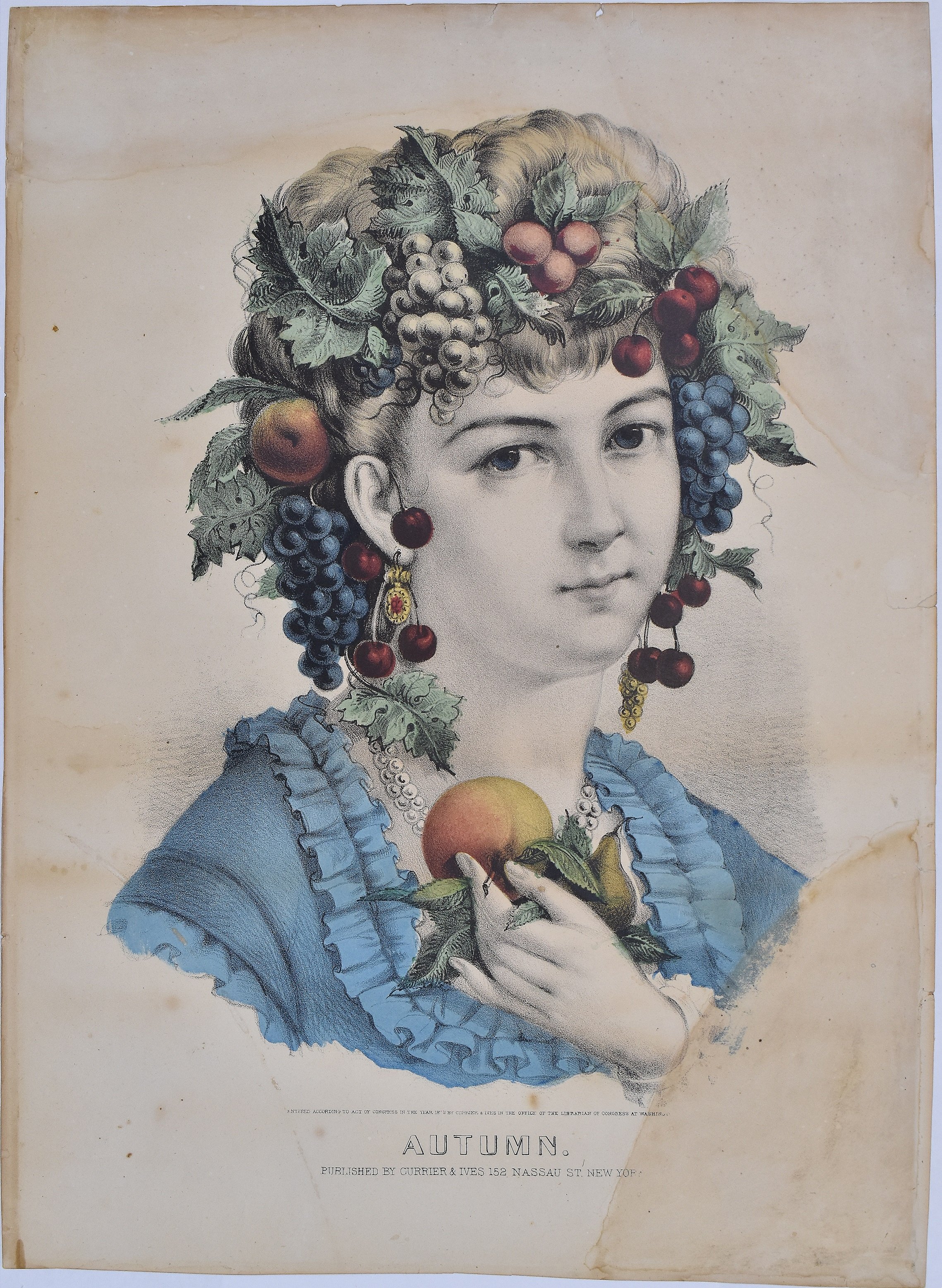
Currier and Ives
Decorative art and collecting for collecting’s sake
Currier & Ives capitalized on popular interests, cheap labour, and recent technology to sell decorative art to the masses.
From 1835 to 1907, these New York lithographers made and sold thousands of copies of over 7,000 images.
These lithographs were designed by hired artists, printed in black ink by shop hands, and coloured by hand, with watercolour paints, by women they employed.
The artists were usually uncredited.
“The Rose” lithograph. Currier & Ives, USA, circa 1870. 12”x16”. 1994.8.12
“Midnight Race on the Mississippi” lithograph. Currier & Ives, USA, 1875. 30 x 40 cm. 1994.1.19
Steamboats, invented in 1807, were another popular new technology. Currier & Ives produced more than 200 lithographs depicting them.
Lithography was invented in 1798.
In the history of printmaking, it is a relatively recent innovation. This printmaking process is based on the immiscibility of oil and water.
Though it is now considered complicated and used primarily for fine art, at the time it was innovative and practical because it could produce most prints in less time than traditional printmaking methods.
Detail of 1989.1.17
“Our Pets, Wide Awake” lithograph. Currier & Ives, USA, 1877-1894. 34 x 42 cm. 1989.1.66
“Londonderry on the River Foyle, Ireland” lithograph. Currier & Ives, USA, 1872-1874. 34 x 44 cm. 1994.8.8

Trends and art movements of the Victorian era tell us more about Currier & Ives and about the style of collecting that Jean Shields enjoyed.
Jean Shields collected like an aesthete.
The Aesthetic movement of the late 19th century encouraged “art for art’s sake,” rejecting the Victorian notion that art should serve a moral or educational purpose.
Jean’s lithograph collection reveals her taste for purely decorative art, and her ceramics feature Orientalist inspiration that the Aesthetic movement also favoured.
“A Home on the Mississippi” lithograph. Currier & Ives, USA, 1871. 30 x 40 cm. 1994.1.17

Currier & Ives lithographs portrayed current events and popular tastes and ideas.
Beyond the idyllic and sentimental scenes they are remembered for, Currier & Ives produced imagery of bigotry, such as their very popular and very anti-Black “Darktown Comics” series from the 1880s-1890s.
Those pieces are not part of Jean’s collection but are worth mentioning as an important part of Currier & Ives’ history, complicating romantic notions about these printmakers.
Consider this scene in the context of Currier and Ives’ racist lithographs. Does it depict Black people differently than white people? How?

Early Victorians typically decorated their walls with paintings and framed prints like these.
Later Victorian art movements changed how people thought and what they purchased, signalling the beginning of the end for Currier & Ives.
Most Currier & Ives prints were decorative. Because they were both decorative and affordable, homeowners could change them out frequently. This biblical print might have stayed up longer, due to its edifying subject matter.
“Noah’s Ark” lithograph. Currier & Ives, USA, 1872-1874. 27 x 35 cm. 1994.8.6
The Arts and Crafts movement changed how people thought about decorative art.
This late Victorian movement criticised the alienating effects of industrialization on workers and artists/designers.
It promoted good design and good living by encouraging a shift towards small-scale workshops – in essence, the opposite of Currier & Ives.
The movement prompted shifts in interior decoration and contributed to the changing popularity and public perception of mass-produced prints.
“Summer” lithograph. Currier & Ives, USA, 1871. 29 x 40 cm. 1994.1.22
By the late 19th century, ideas about interior decoration changed. Consumers sought pieces other than prints.
A new Arts and Crafts–inspired style of interior decoration sought to create harmony between architecture and decoration.
It used larger, more dimensional pieces than these prints to decorate walls – like murals, tapestries, and elaborately carved woodworking.
“Autumn” lithograph. Currier & Ives, USA, 1870-1871. 29 x 40 cm. 1994.1.23
Lithography eventually gained a reputation as mass-produced, unartistic, and ingenuine.
Consumers of prints became concerned with quality and originality.
“Art prints” courted this audience by using numbered or graded editions that were often signed by the printmaker and/or artist.
Though they were not necessarily more artistic than lithographs like those produced by Currier & Ives, art prints were still seen as superior.
“Winter” lithograph. Currier & Ives, USA, 1870. 29 x 40 cm. 1994.1.20
Currier & Ives weathered these changes as best they could, but eventually closed in 1907.
“Spring” lithograph. Currier & Ives, USA, 1870. 29 x 40 cm. 1994.1.21
Early 20th century interest in American art history more than rehabilitated Currier & Ives’ reputation.
Artists, historians, and collectors found new meaning in the work of Currier & Ives.
Their prints represented the history of American graphic art and provided inspiration for new art.
By 1929, these lithographs’ lasting reputation had been established.
When Jean was collecting these prints, they would have been seen as representations of a romantic bygone era.
“A New England Home” lithograph. Currier & Ives, USA, 1852-1872. 30 x 40 cm. 1994.1.18
“The Young Housekeepers, The Day After Marriage” lithograph. Nathaniel Currier, USA, 1848. 30 x 40 cm. 1989.1.67
This lithograph was produced in Nathaniel Currier’s shop four years before it became Currier and Ives.
“Phebe” lithograph. Currier & Ives, USA, 1835-1907. 25 x 36 cm. 1994.8.7

The enduring idea of Currier and Ives holds their prints as picturesque illustrations of a golden era of American history.
They are thought to represent a romantic, heroic time of simple values, domestic joy, and prosperity.
But the sentimental scenes and pleasant imagery in these lithographs are decorative, not factual. They reflect what Victorians wanted to see in their homes, not how life truly was in the complex times they lived in.
“The Hundred Leaf Rose” lithograph. Currier & Ives, USA, 1870. 30 x 40 cm. 1994.8.11























